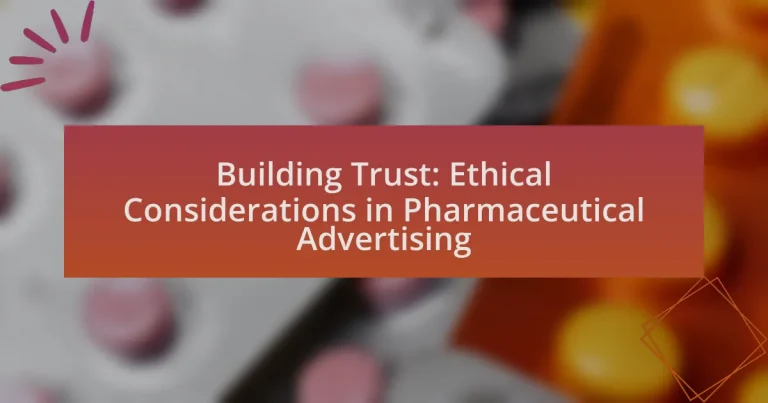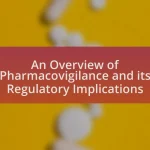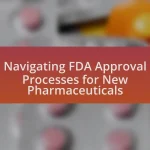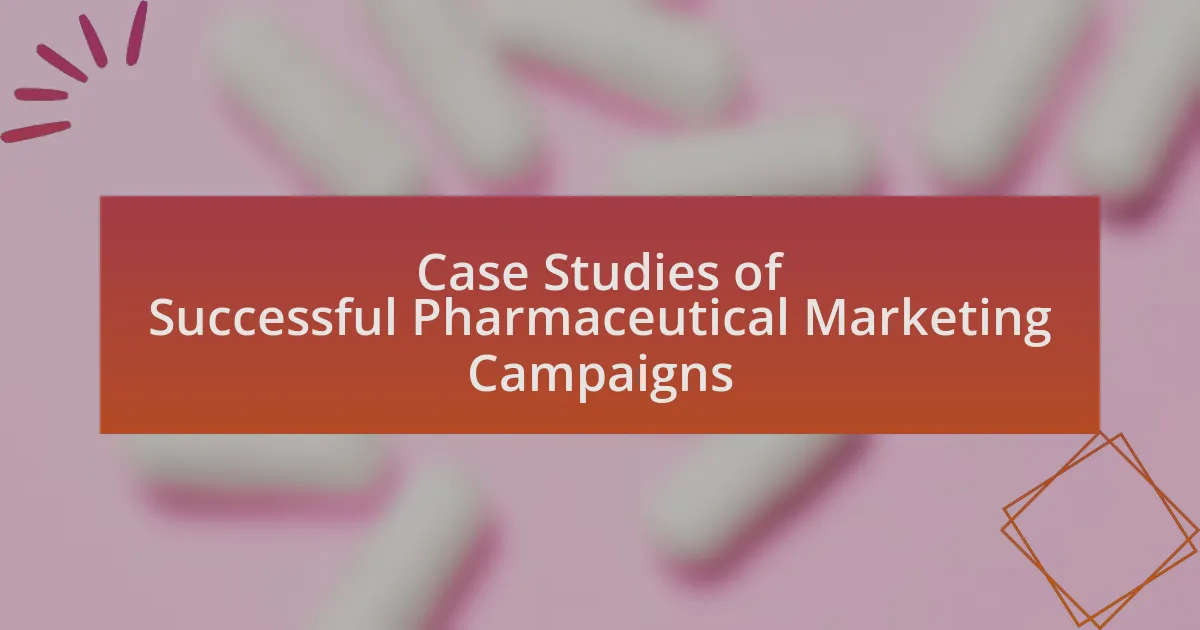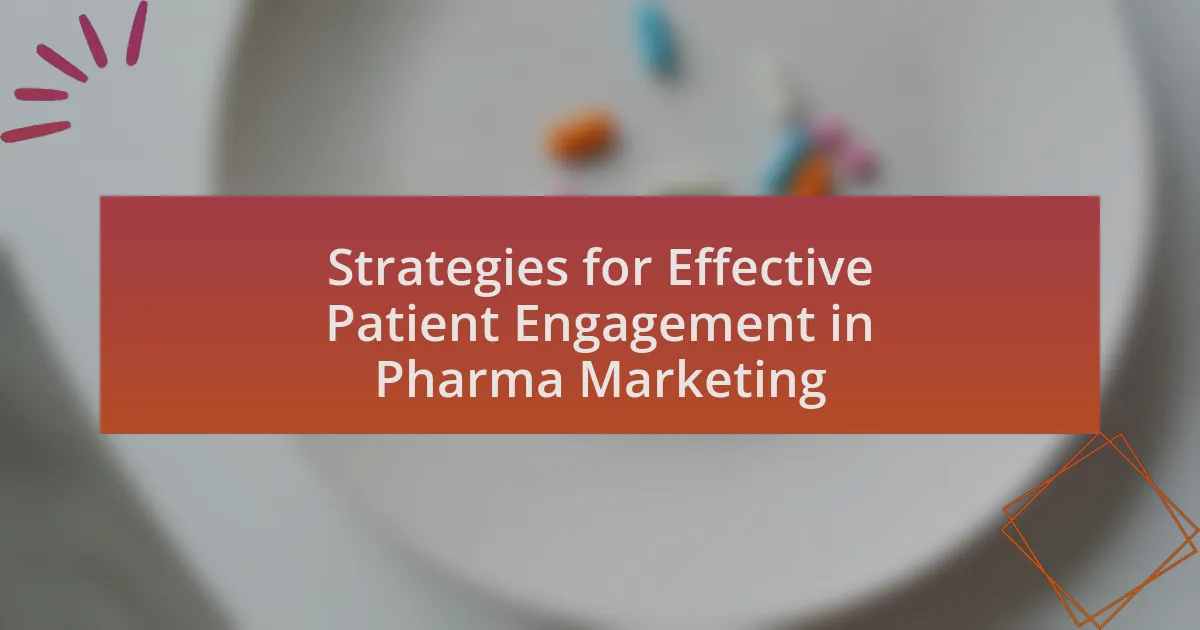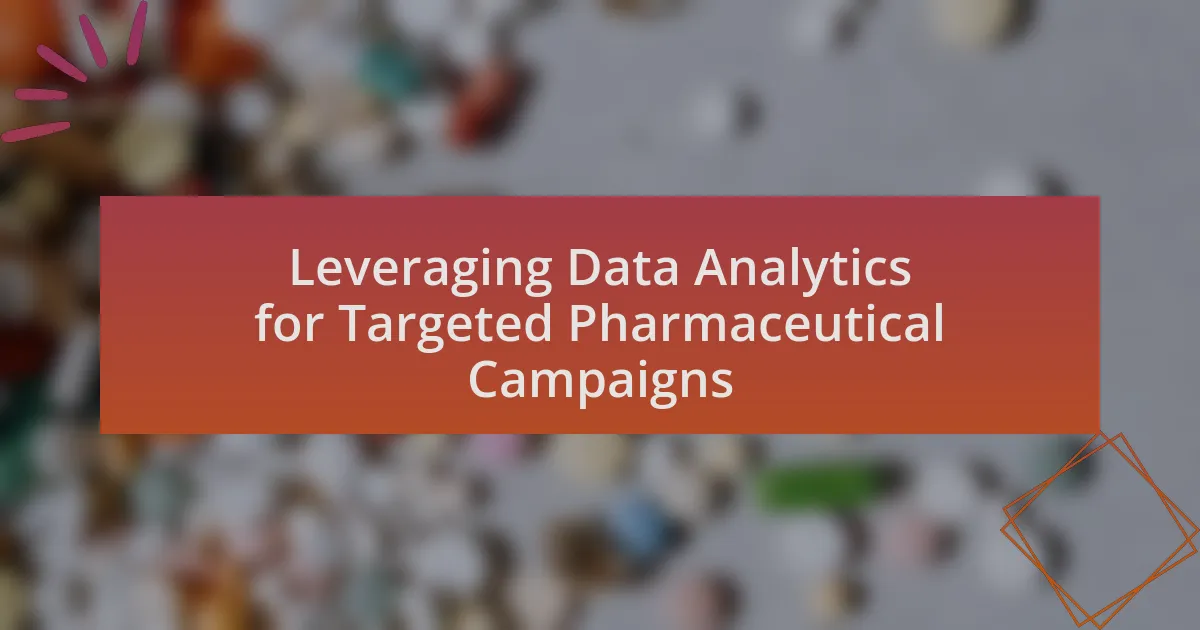The article focuses on the ethical considerations in pharmaceutical advertising, emphasizing the importance of truthful representation of drug efficacy and safety, transparency about potential side effects, and the avoidance of misleading claims. It discusses how ethical advertising fosters trust between healthcare providers, patients, and pharmaceutical companies, ultimately impacting public health outcomes. The article also outlines the regulations governing pharmaceutical advertising, the role of oversight organizations, and the consequences of unethical practices. Additionally, it highlights best practices for ethical advertising, the significance of stakeholder engagement, and strategies for consumers to critically evaluate pharmaceutical advertisements.
What are the ethical considerations in pharmaceutical advertising?

Ethical considerations in pharmaceutical advertising include the need for truthful representation of drug efficacy and safety, transparency about potential side effects, and the avoidance of misleading claims. These considerations are crucial because they directly impact patient safety and informed decision-making. For instance, the American Medical Association emphasizes that advertisements should not exaggerate benefits or downplay risks, as this can lead to inappropriate use of medications. Additionally, ethical advertising must respect the autonomy of healthcare providers and patients, ensuring that information is presented in a way that supports informed choices rather than coercing or manipulating them.
Why is ethical advertising important in the pharmaceutical industry?
Ethical advertising is crucial in the pharmaceutical industry because it fosters trust between healthcare providers, patients, and pharmaceutical companies. Trust is essential for patients to feel confident in the medications they are prescribed, which directly impacts their health outcomes. Ethical advertising ensures that information about drugs is accurate, transparent, and not misleading, thereby enabling informed decision-making. For instance, the American Medical Association emphasizes that ethical marketing practices can enhance the credibility of pharmaceutical companies and improve public health by promoting responsible use of medications.
What are the potential consequences of unethical advertising practices?
Unethical advertising practices can lead to significant consequences, including loss of consumer trust, legal repercussions, and damage to brand reputation. When companies engage in misleading or deceptive advertising, they risk alienating their customer base, as consumers are likely to feel betrayed upon discovering the truth. According to a study published in the Journal of Business Ethics, 70% of consumers reported that they would stop purchasing from a brand that they perceived as dishonest. Additionally, unethical practices can result in regulatory actions, such as fines or sanctions from government agencies, which can further harm a company’s financial standing. The cumulative effect of these consequences can severely impact a company’s long-term viability and market position.
How does ethical advertising impact public trust in pharmaceuticals?
Ethical advertising significantly enhances public trust in pharmaceuticals by promoting transparency and accountability. When pharmaceutical companies engage in ethical advertising practices, they provide accurate information about their products, including potential risks and benefits, which fosters a sense of reliability among consumers. Research indicates that 70% of consumers are more likely to trust a pharmaceutical brand that prioritizes ethical advertising practices, as it demonstrates a commitment to patient welfare over profit. This trust is crucial, especially in an industry where misinformation can lead to serious health consequences.
What regulations govern pharmaceutical advertising?
Pharmaceutical advertising is governed by regulations such as the Federal Food, Drug, and Cosmetic Act (FDCA) in the United States, which mandates that advertisements must be truthful and not misleading. Additionally, the Food and Drug Administration (FDA) oversees the advertising of prescription drugs, requiring that promotional materials include balanced information about risks and benefits. The Prescription Drug Marketing Act (PDMA) also imposes restrictions on the distribution and promotion of prescription drugs to ensure ethical practices. These regulations are designed to protect consumers and ensure that pharmaceutical companies provide accurate information about their products.
Which organizations oversee pharmaceutical advertising standards?
The organizations that oversee pharmaceutical advertising standards include the Federal Trade Commission (FTC) in the United States, the Food and Drug Administration (FDA), and the European Medicines Agency (EMA) in Europe. The FTC regulates advertising to ensure it is not misleading or deceptive, while the FDA specifically oversees the promotion of prescription drugs to ensure compliance with federal law regarding drug advertising. The EMA provides guidelines and regulations for pharmaceutical advertising within the European Union, ensuring that marketing practices are ethical and transparent. These organizations collectively enforce standards that promote truthful and responsible advertising in the pharmaceutical industry.
What are the key regulations that pharmaceutical companies must follow?
Pharmaceutical companies must follow key regulations such as the Food, Drug, and Cosmetic Act, the Drug Enforcement Administration regulations, and the guidelines set forth by the Food and Drug Administration. These regulations ensure the safety, efficacy, and security of pharmaceutical products. The Food, Drug, and Cosmetic Act mandates that all drugs must be proven safe and effective before they can be marketed, while the Drug Enforcement Administration regulates controlled substances to prevent abuse. Additionally, the FDA provides guidelines for advertising and promotion, requiring that claims made in advertisements are truthful and not misleading, thereby fostering trust in pharmaceutical advertising practices.
How do pharmaceutical companies build trust through advertising?
Pharmaceutical companies build trust through advertising by emphasizing transparency, providing clear information about drug benefits and risks, and engaging with healthcare professionals. These strategies foster credibility and reliability among consumers. For instance, many companies disclose clinical trial results and side effects in their advertisements, which aligns with regulatory requirements and enhances consumer confidence. Additionally, partnerships with healthcare providers in promotional campaigns can reinforce trust, as these professionals often serve as credible sources of information. Research indicates that transparency in advertising correlates with increased consumer trust, as seen in studies published in journals like the Journal of Medical Marketing.
What strategies can be employed to enhance transparency in advertising?
To enhance transparency in advertising, companies can implement clear disclosure practices regarding the sources of funding and potential conflicts of interest. For instance, pharmaceutical companies should openly communicate the financial relationships with healthcare professionals and organizations involved in their advertising campaigns. Research indicates that transparency in these relationships can significantly improve public trust; a study published in the Journal of Medical Ethics found that 70% of consumers are more likely to trust advertisements that disclose funding sources. Additionally, utilizing plain language in advertisements and providing accessible information about the products, including side effects and efficacy, further supports transparency and helps consumers make informed decisions.
How can pharmaceutical companies effectively communicate risks and benefits?
Pharmaceutical companies can effectively communicate risks and benefits by utilizing clear, transparent language and providing comprehensive information through multiple channels. This approach ensures that patients and healthcare providers understand both the potential advantages and the associated risks of medications. Research indicates that when companies present data in an accessible format, such as visual aids or simplified summaries, comprehension improves significantly, leading to informed decision-making. For instance, a study published in the Journal of Health Communication found that patients who received information in a clear and concise manner were more likely to adhere to treatment plans and report satisfaction with their healthcare experience.
How does the public perceive pharmaceutical advertising?
The public generally perceives pharmaceutical advertising with skepticism and concern regarding its ethical implications. Research indicates that many individuals believe such advertising prioritizes profit over patient welfare, leading to distrust in pharmaceutical companies. A survey conducted by the Pew Research Center found that 70% of Americans think that pharmaceutical companies put profits ahead of the needs of patients. Additionally, concerns about the accuracy of information presented in advertisements contribute to this skepticism, as many consumers feel overwhelmed by the volume of promotional content and question its reliability.
What factors influence public trust in pharmaceutical advertisements?
Public trust in pharmaceutical advertisements is influenced by several key factors, including transparency, credibility of sources, regulatory compliance, and the perceived integrity of the pharmaceutical companies. Transparency in disclosing potential side effects and the financial backing of the advertisements enhances trust, as consumers feel more informed about the risks and benefits. Credibility is bolstered when advertisements are supported by reputable medical professionals or organizations, which can lend authority to the claims made. Regulatory compliance, such as adherence to guidelines set by the FDA, also plays a crucial role; studies show that advertisements that follow these regulations are viewed more favorably by the public. Lastly, the perceived integrity of pharmaceutical companies, shaped by their history and public relations efforts, significantly impacts trust levels, as consumers are more likely to trust companies that demonstrate ethical practices and social responsibility.
How do consumer experiences shape perceptions of pharmaceutical marketing?
Consumer experiences significantly shape perceptions of pharmaceutical marketing by influencing trust and credibility. Positive experiences, such as effective treatments and transparent communication, enhance consumer trust in pharmaceutical brands, leading to favorable perceptions of their marketing efforts. Conversely, negative experiences, such as adverse side effects or misleading information, can result in skepticism and distrust towards pharmaceutical advertising. Research indicates that 70% of consumers are more likely to trust a pharmaceutical company if they have had a positive experience with its products, highlighting the direct correlation between consumer experiences and marketing perceptions.
What are the common ethical dilemmas faced in pharmaceutical advertising?
Common ethical dilemmas faced in pharmaceutical advertising include misleading claims, the promotion of off-label drug use, and the prioritization of profit over patient welfare. Misleading claims can occur when advertisements exaggerate the benefits or downplay the risks associated with medications, potentially leading to patient harm. The promotion of off-label drug use raises ethical concerns as it may encourage healthcare providers to prescribe medications for unapproved indications, which can compromise patient safety. Additionally, the focus on profit can lead to aggressive marketing strategies that prioritize sales over the well-being of patients, undermining trust in the pharmaceutical industry. These dilemmas highlight the need for ethical standards and regulations to ensure responsible advertising practices.
How do companies balance profit motives with ethical responsibilities?
Companies balance profit motives with ethical responsibilities by integrating corporate social responsibility (CSR) into their business models. This approach ensures that profit generation does not compromise ethical standards, particularly in sensitive sectors like pharmaceuticals. For instance, pharmaceutical companies often adhere to strict regulatory guidelines and ethical codes, such as those established by the American Medical Association, to ensure that advertising practices do not mislead consumers or promote harmful products. By prioritizing transparency and patient welfare, these companies can maintain public trust while still pursuing financial success. Research indicates that companies with strong ethical practices can enhance their brand reputation, leading to increased customer loyalty and, ultimately, higher profits.
What role does misinformation play in ethical dilemmas?
Misinformation significantly complicates ethical dilemmas by distorting the truth and influencing decision-making processes. In the context of pharmaceutical advertising, misinformation can lead to misguided perceptions about drug efficacy and safety, ultimately affecting patient trust and health outcomes. For instance, studies have shown that misleading claims in advertisements can result in patients making uninformed choices, which raises ethical concerns regarding the responsibility of pharmaceutical companies to provide accurate information. This manipulation of information not only undermines public trust but also poses moral questions about the integrity of healthcare practices.
What best practices can pharmaceutical companies adopt for ethical advertising?
Pharmaceutical companies can adopt several best practices for ethical advertising, including transparency in communication, accurate representation of drug benefits and risks, and adherence to regulatory guidelines. Transparency involves clearly disclosing all relevant information about a medication, including side effects and contraindications, which helps build trust with healthcare professionals and patients. Accurate representation ensures that advertisements do not exaggerate benefits or downplay risks, aligning with the standards set by regulatory bodies like the FDA. Adhering to guidelines, such as those outlined by the American Medical Association, reinforces ethical practices and promotes responsible marketing. These practices are essential for maintaining credibility and fostering a positive relationship with the public and healthcare community.
How can companies ensure compliance with ethical standards?
Companies can ensure compliance with ethical standards by implementing comprehensive training programs for employees that emphasize ethical practices and decision-making. These programs should include clear guidelines on ethical behavior, regular assessments, and updates to reflect changing regulations and societal expectations. Research indicates that organizations with robust ethics training see a significant reduction in unethical behavior, as employees are better equipped to recognize and address ethical dilemmas. Additionally, establishing a transparent reporting system for ethical concerns encourages accountability and fosters a culture of integrity within the organization.
What role does stakeholder engagement play in ethical advertising practices?
Stakeholder engagement is crucial in ethical advertising practices as it fosters transparency and accountability. Engaging stakeholders, including consumers, healthcare professionals, and regulatory bodies, ensures that advertising messages are aligned with their values and expectations. This alignment helps to build trust, as stakeholders feel their perspectives are considered, leading to more responsible advertising that prioritizes public health and safety. Research indicates that companies that actively involve stakeholders in their advertising strategies are more likely to adhere to ethical standards and avoid misleading claims, thereby enhancing their reputation and consumer loyalty.
How can consumers critically evaluate pharmaceutical advertisements?
Consumers can critically evaluate pharmaceutical advertisements by analyzing the claims made, scrutinizing the evidence provided, and considering the potential biases of the source. Evaluating the clarity and specificity of the information presented helps determine if the advertisement is transparent about the drug’s benefits and risks. Additionally, consumers should check for independent research or clinical trials that support the claims, as well as review any potential conflicts of interest related to the sponsoring pharmaceutical company. For instance, the American Medical Association emphasizes the importance of understanding the context and scientific backing of advertised medications to make informed decisions.
What questions should consumers ask when assessing pharmaceutical ads?
Consumers should ask the following questions when assessing pharmaceutical ads: What is the drug’s intended use, and what are the potential side effects? Understanding the drug’s purpose and risks is crucial for informed decision-making. Additionally, consumers should inquire about the clinical evidence supporting the drug’s effectiveness and whether the ad presents this information transparently. They should also consider who funded the research and if there are any conflicts of interest. Furthermore, consumers should ask if the ad includes information about alternative treatments and whether it accurately represents the drug’s benefits compared to those alternatives. Lastly, consumers should evaluate whether the ad targets a specific demographic and if it adheres to ethical advertising standards. These questions help ensure that consumers are making well-informed choices based on reliable information.
How can consumers identify misleading information in advertisements?
Consumers can identify misleading information in advertisements by critically evaluating the claims made, checking for evidence, and being aware of common tactics used to mislead. They should look for specific details such as the presence of disclaimers, the clarity of language, and whether the advertisement provides scientific backing for its claims. Research indicates that advertisements often use vague language or emotional appeals to distract from the lack of substantial evidence, which can mislead consumers. For example, a study published in the Journal of Advertising Research found that 70% of consumers could not identify misleading claims when emotional appeals were used, highlighting the importance of skepticism and thorough examination of the information presented.
